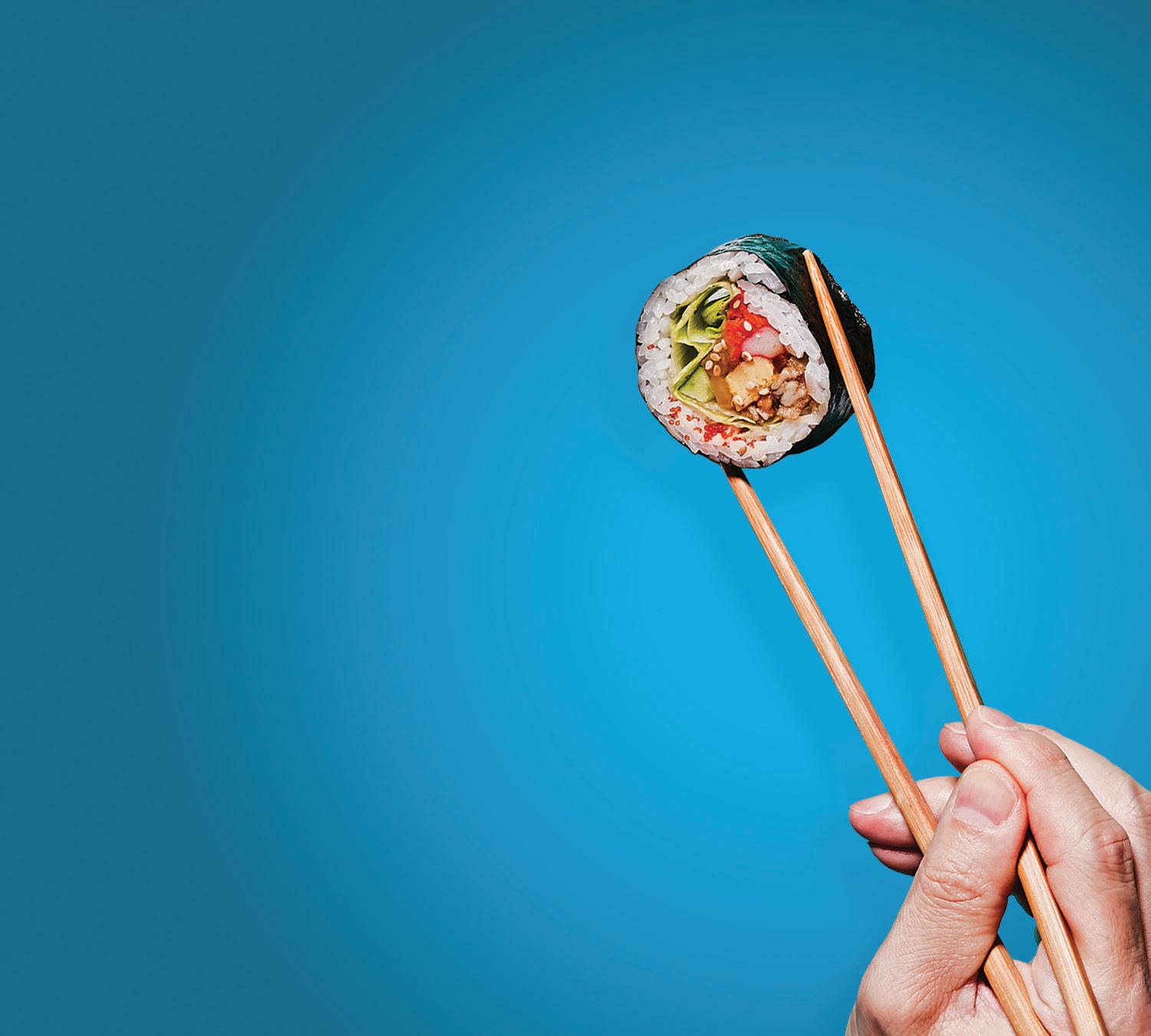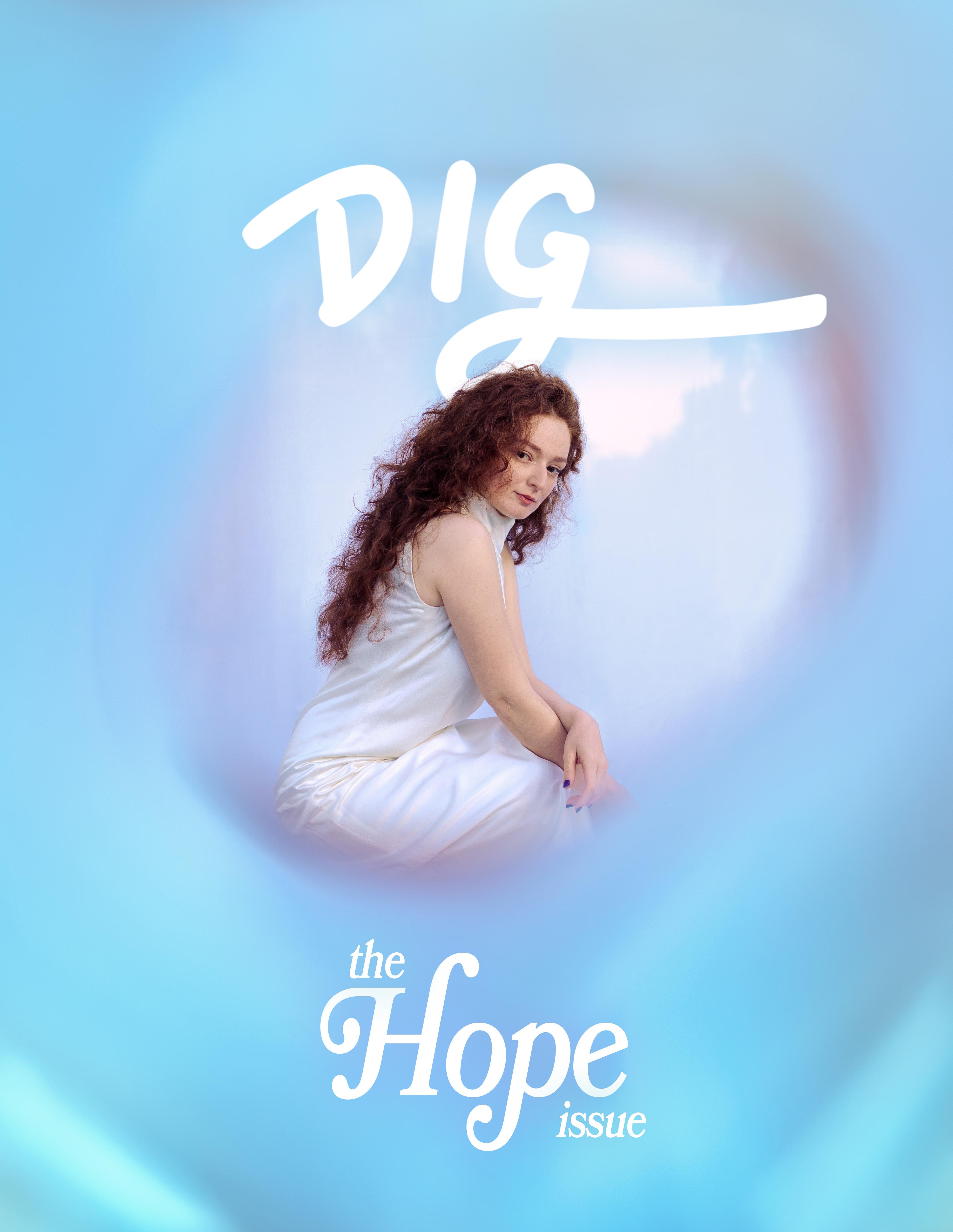


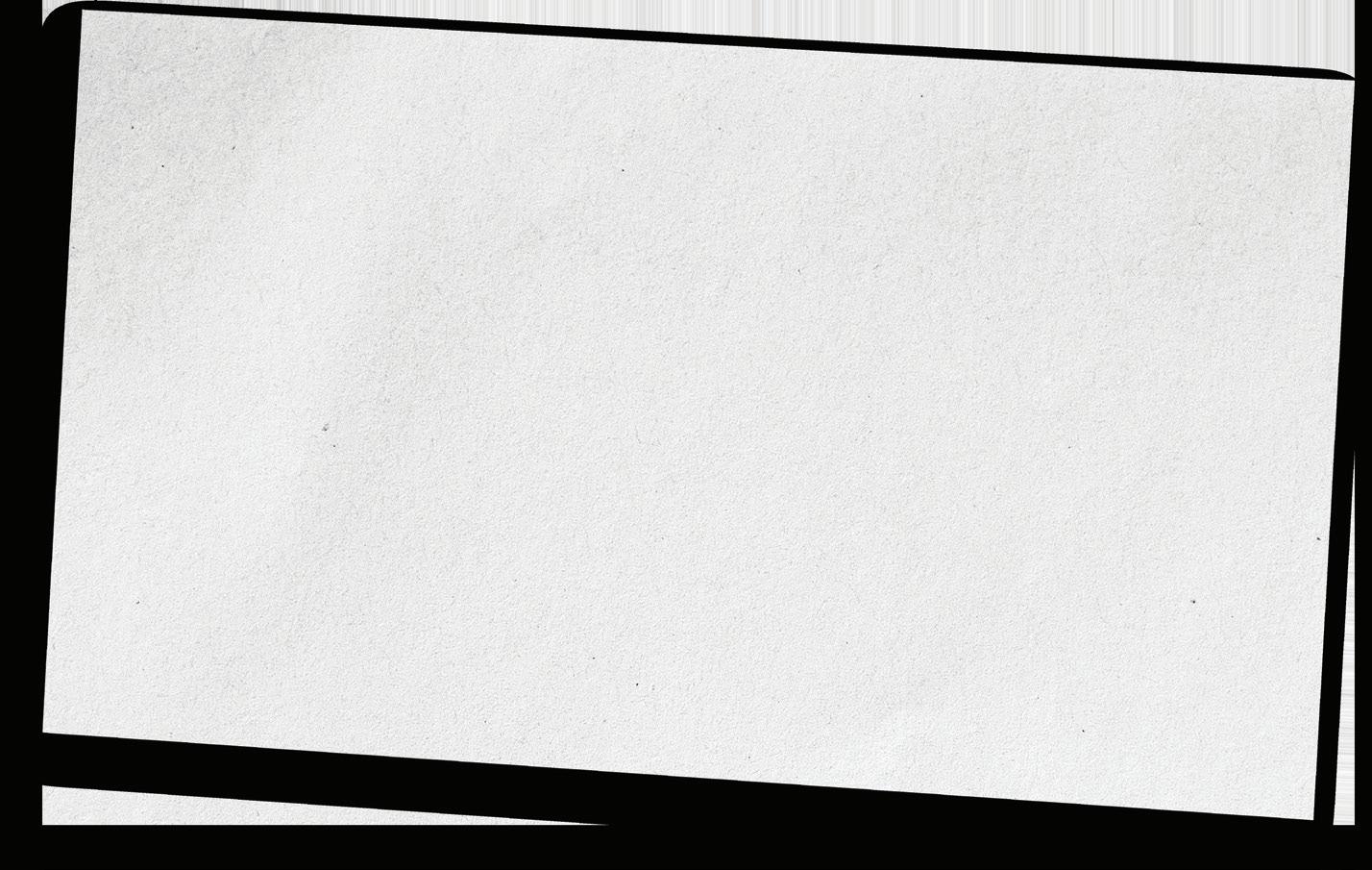











LB INSIDERS
EDITOR’S NOTE
BY DARYA JAFARINEJAD
BY ANNA PHAM
18 WHILE I WAIT TO REMEMBER
BY ASTER HALLAS WHERE TO NEXT: QUEER-FRIENDLY TATTOO SHOPS
DIG IN: HOLEY GRAIL BY TAZMIN MCGILL DIG THE LOOK: BRAIDS WITH INTENTION 10 BY LUIS CASTILLA HIDDEN FIGURES: HEALING GEMS BY ULKU SIMSEK
After enduring a terrible car crash and suffering a traumatic brain injury, one young woman bravely and persistently battles against memory loss.
WILD DREAMS OF THE UNDERDOGS
BY DANIEL PETERS
12 3 22 THE SISTERHOOD OF THE LONG BEACH WALKING CLUB PLASTIC LABOR OF NECESSITY
5 BY SALYSSA DURAN A SHORT STORY BY JAMES ANEAR A POEM BY JAMES HULL 8
Re:Wild CSULB wants to say byebye to pesticides and hello to an organic campus, and they have a plan to make it happen.
What if you combined fitness with bonding? The Long Beach Walking Club, a free walking club for women, does just that, promoting sisterhood through events and opportunities.






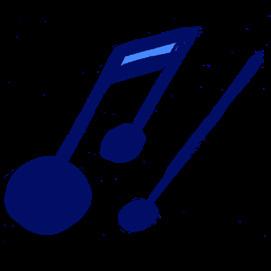











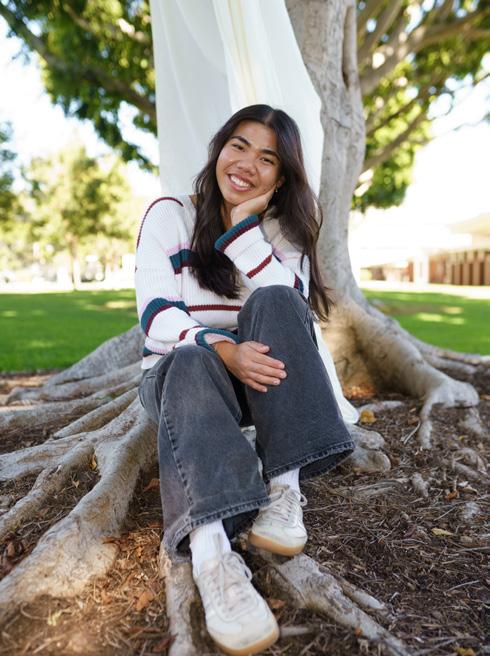





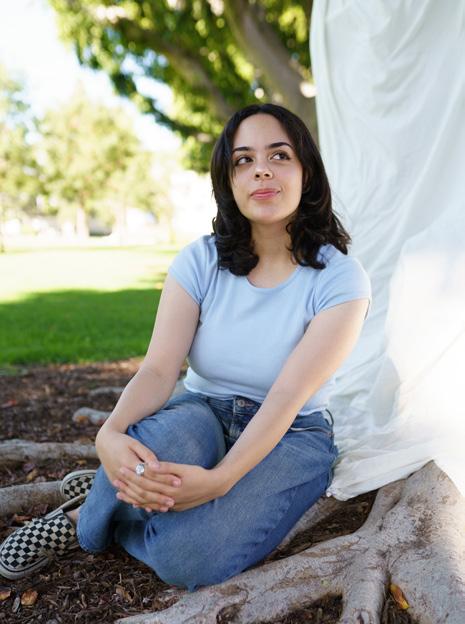





DIG is a student-produced arts and culture magazine published by CSULB’s Department of Journalism and Public Relations. We inspire readers to immerse themselves in the Long Beach lifestyle through photography, videography, design, illustration and the written word.



I wished on a dead star.
To be fair, I didn’t know it was dead. See, the way light-years work is the light from a distant star (say, 73 million light years) reaches us in 73 million years. Basically, we see that star as it was 73 million years ago. Cool, right? Scientists have ways of determining whether stars are dead or not.
But I’m no scientist. I’m a grain of sand in the scale of the vast universe. I often feel smaller than that. A grain of a grain of sand. It’s easy, comfortable even, to feel hopeless. It’s like an extra limb or a soft pillow—you become dependent on it.
Yet, Pandora never released Hope from her box. We were not born hopeless. Hope is a burning ember you keep locked in the treasure chest of your heart. It is the helium that lifts you past the skies, into the ether; the domain of reckless dreams and hopeful romantics.
It is why I can wish on a dead star. Even though it’s dead, its light still shines. Fiercely. Boldly. Unwaveringly. We are still impacted by it, even if by sight alone. Its legacy lives on, as we continue looking to it for guidance. Trust our dreams to it in whispered secrets.
Its legacy, its light, inspires the hopeless to hope again. Even in the darkest of nights.


STORY & PHOTOS BY TAZMIN MCGILL
the hair is intertwined into locs, cornrows, or box braids, braided styles have long been a staple in the Black community, tied to a rich history. However, braids have grown to mean so much more than just a way to protect natural hair from damage caused by heat or constant maintenance.
However, trends like this call for a rise in ultra accessorizing while keeping the basics – well, basic. Whether it be rings on every finger, bags with a lot of trinkets, or those chunky "dad" shoes, more people are using accessories to express personal style. For some students at CSULB, this includes their hair.
From Janet Jackson’s thick mid-back length Poetic Justice box braids popularized by her character in the 1993 film by the same name, to the blonde waist-length Formation braids worn by Beyonce, braids are seeing a resurgence and being used as a way to tell a story and emphasize personality.
Though using hair to express personal style is not new, there is an even greater importance placed on it now. As quickly as trends like Y2K and its signature cropped tops and low-rise bottoms and the various shades of pink signaling a "Barbiecore" awakening came, they faded away. The styles that remain timeless are ones that are a mix of practicality and fashion – styles that one might call very demure, very mindful.

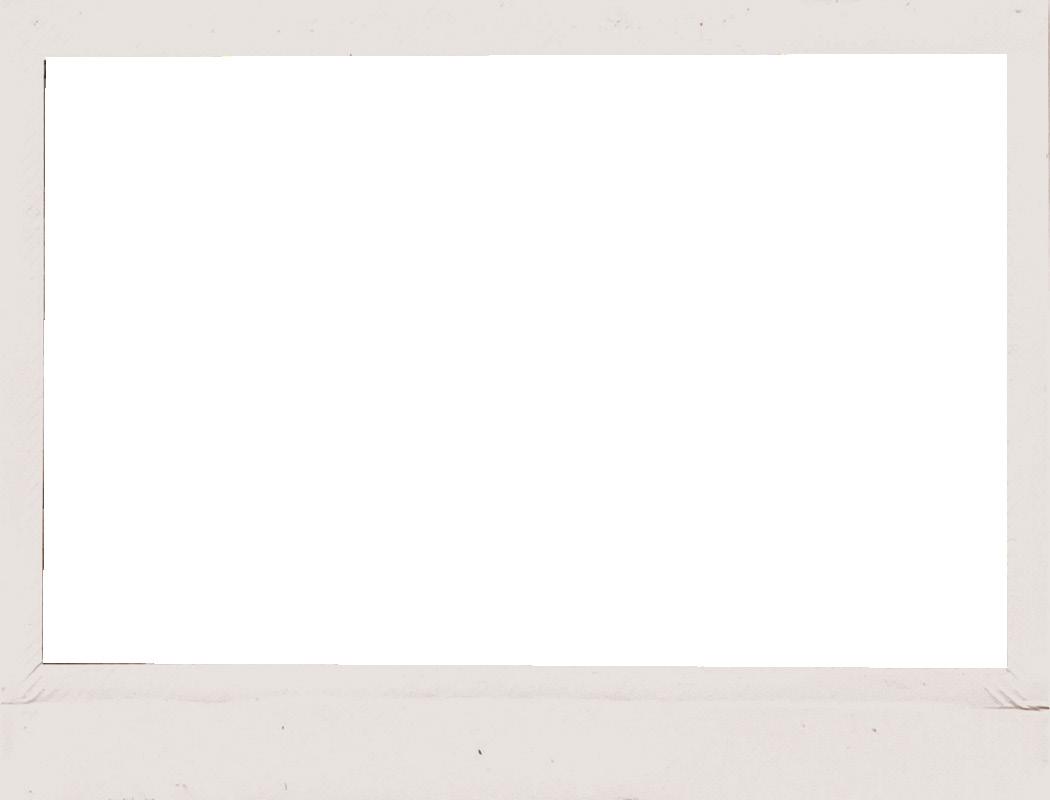
Box braids now have a sister style called knotless braids, which uses the technique of braiding one’s natural hair first, then adding in braid hair extensions. Knotless braids gained traction as a style that provides a cleaner look than the old faithful box braids.
Other unique styles like Goddess, Mermaid and French Curl braids have gained popularity in recent years as a way to add flair to the standard box or knotless braids. Thick like the Poetic Justice style, Goddess braids differ because the wavy or curly strands of hair are left out to frame the braids. With the Mermaid style, hair is braided to a certain point, and loose curls are then left at the end, making for an effortless look. Similar to Mermaid braids, the French Curl style involves hair braided to the desired length, but instead of loose curls at the end, these braids are marked by curls which are dramatic and defined.
Whether these styles are chosen to signify a new chapter or pay homage to family traditions, students are using the box braid blueprint to elevate their personal style and share their stories.



Due to her aversion to getting her hair done, cinematic arts student Jada Payne started her loc journey seven years ago. Although she was not a fan of her locs in their early stage, she grew to love them as they grew in length.
Payne now estimates she spends $150 per retwist appointment because her hair now “resembles resilience, and the idea of keeping something and pushing through with something,” Payne said.
Kalani Overall loves getting her hair braided, and knotless braids are her style of choice. The protective style not only gives her a clean look, but it also gives her time back in her busy life.
“It’s an experience,” Overall said. “You get to sit in the chair for a long time, it takes hours, but honestly, I like it. It represents my culture.”
Her burgundy colored braids also keep her connected to her family and their tradition. “Everybody in my family gets burgundy,” Overall said. “My mom, my aunt, actually both my aunts, [and] literally all my cousins.”


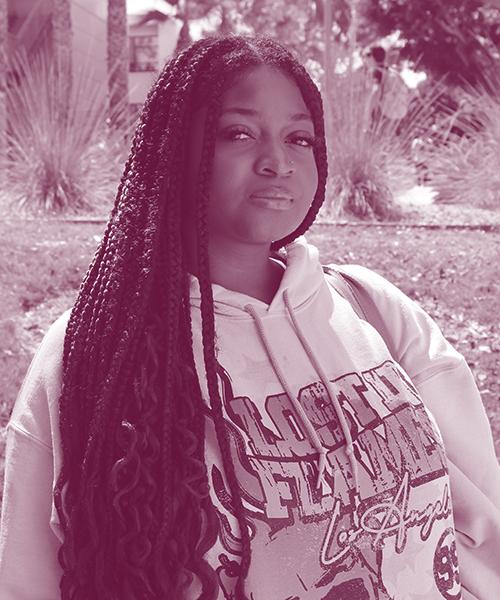

In the past, kinesiology student Jeremiah Broom had his hair in braids, but he grew tired of the process and opted to get locs. Although he originally chose this hairstyle for convenience, he now views his hair as a source of motivation and representation of where he has been and where he is today. Broom has made the steps to get rid of things that no longer serve a purpose for his future, but his hair reminds him that “it’s okay to keep something.”
“Everybody’s got their own story when it comes to their hair,” Broom said. “Everything I overcame, I did it with my hair.”
Growing up in and out of her mom’s hair salon, pre-civil engineering major Maddie Mathis sees how hair can affect both someone’s personality and their perception of themselves. Mathis has been exploring ways to use her hair to compliment her personal style.
“I just recently started doing my own hair to express more color into my life. I wear a lot of neutral-tone clothing, so I wanted to be able to express how much I love color and experimenting with different looks through my hair,” Mathis said. “Adding color to my hair or braiding my hair down to look like an undercut helps me express that without having to damage my hair by cutting or dying it.”



In exchange for personal convenience, first-year Lauren Womack spent more than $300 and hours in a styling chair for her extra, extra small braids. Just one braid size larger than the legendary micro braids, Womack’s decision to invest in her hairstyle comes with the need for a quick and easy way to manage her hair as she starts her first semester at CSULB.
Intending to keep her braids for two to three months, Womack views her hairstyles as an accessory to her everyday look, and the fact that she can do multiple styles with her hair is like accessorizing an accessory.
“You don’t always have to wear a ponytail. You can do a cute half up, half down. You can do a cute little braid, a high bun or low bun,” Womack said.
For business marketing student Mo Ayeni, new hair signifies new chapters. She reminisces about the near weekly hairstyle changes she had when in Nigeria because of the low price.
No matter the type of braids she gets, Ayeni values longevity and versatility so she can alter them into different styles for a longer period of time than she would in Nigeria. As the next season and chapter for Ayeni approaches, she is ready for something new. She is considering changing her hairstyle to either French Curl braids in a bob length or just coloring her natural hair.
“We’ll see,” Ayeni said. “I do want to do a big chop soon – start a new chapter. I’m in college now, you know.”


Fashion merchandising and design student Darius Davis’ loc journey was kickstarted by his mother at a young age. Although the style did not hold significance for him at first, Davis feels like cutting his locs now would be like losing a part of himself.
“Like my hands, my fingers, my energy… it’s a part of me,” Davis said of his hair. “It is an extension of my energy. It’s a way of personifying myself.”
Although psychology student Seun Adeoye loves her natural 4C hair, she also loves the convenience provided by braids as she balances her course load.
“Having to go to class every single day, it can be a lot to just keep my hair natural,” Adeoye said. “These took two days to do, but it’s worth it because it saves a lot of time and I like the way I look.”


STORY & PHOTOS BY ANNA PHAM

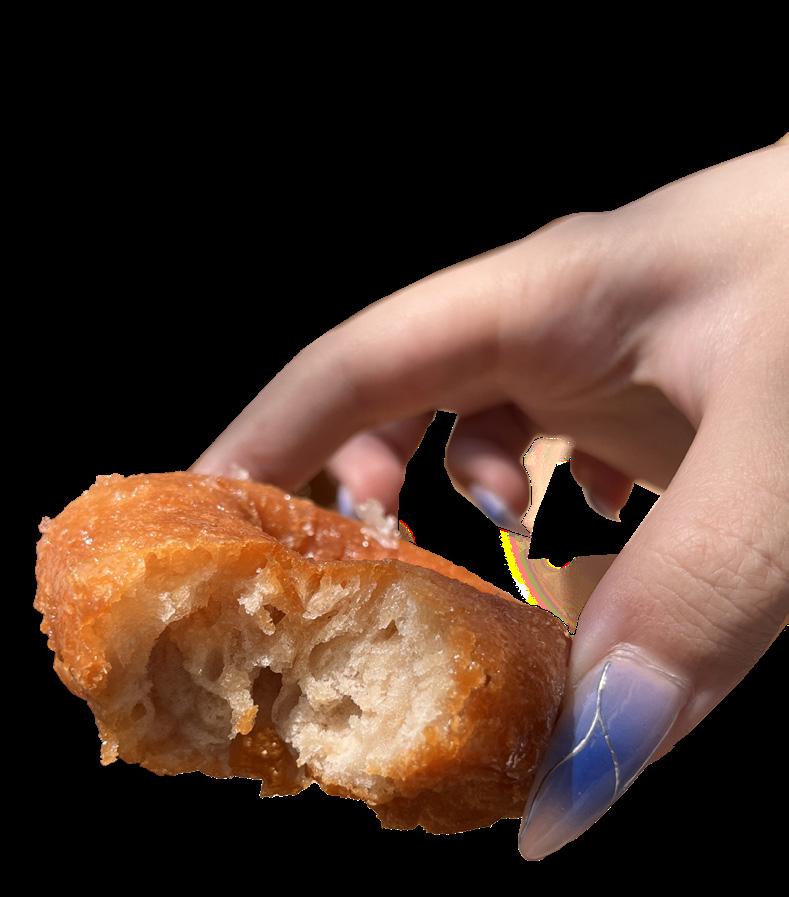
Whatstarted out as a small local business in Hanalei, Kauai, with only a tiny red burger trailer has turned into a popular donut shop called Holey Grail. Its newest outpost opened in Belmont Shore in June, bringing its hand-fried, made-toorder taro donuts to Long Beach.
From the beginning, Holey Grail has put a different twist on its donuts. While most donuts are made with all-purpose flour, eggs, and milk, Holey Grail uses taro starch and coconut cream as their main ingredients, a nod to the company's Hawaiian birthplace. They also make sure that all their ingredients are locally sourced and organic.
Dani, a shift lead at the Belmont Shore store, explains that taro starch “still gives the consistency of a good donut. Taro is called ‘the heart of the island,’ as it was one of the first growing things to exist in Hawaii.
Having taro in the donut brings you back to the source of the home of where it came from.”
The result is a donut with a much different texture from your regular donuts. They're light and airy on the inside but still a little bit crispy on the edges. They aren’t super sweet, either, like you’d expect a donut to be.
Holey Grail has nine different flavor options to choose from, and patrons can purchase them not by the dozen, but in packs of one, four, or nine. They also sell donut holes called “Holeys,” which, like the donuts, are made from their unique taro-based dough batter.
The shop also serves a variety of drinks, ranging from coffees to teas, and soft-serve ice cream made with coconut and taro.
Apart from their classical donut selection, they have a selection



called the "Tasting Box," which consists of four different flavors that change each week.
Dani suggests that newcomers try “the Original Sin, … our top-selling donut [...or] any donut from our ‘Tasting Box’ because those donuts change every Thursday.” She also suggests people try the “Breaking Bread” donut of the month because it's only on the menu for a few weeks, and part of the proceeds go to a charity of the collaborator’s choice. Holey Grail created Breaking Bread as a way to connect and share ideas with other people.
“We team up with different chefs, different celebrities, to come up with a concept donut, and they choose a charity, so we just add an extra dollar to that donut, and that dollar goes to charity,” Dani said.

One of the celebrities they collaborated with was Tony Hawk. Holey Grail created a donut that was flavored with maple, Hawaiian vanilla bean, burnt coconut caramel and flaky salt. Twenty percent of the proceeds from that donut was donated to The Skatepark Project to help the organization's mission in building more skateparks.
A more recent Breaking Bread flavor that Holey Grail released was a collaboration with Thuy Nguyen, a Vietnamese chef from L.A. Together, Holey Grail and Nguyen created a donut made with a pandan glaze, mango coconut crumble, passionfruit and matcha lime drizzle, dusted with lime zest. Proceeds were donated to Action Against Hunger, a charity that helps fight against hunger and food insecurity.
FIND THEM AT
4803 2nd St, Long Beach, CA 90803
holeygraildonuts.com


The oldest tattoo shop in America, Outer Limits sets the standard for how a safe-space tattoo shop should be run. This shop was made possible by the queer owner, Kari Barba, who opened the shop in 1983. With over 45 years of tattoo experience, Barba is known by the locals as the “mother of tattoos.”
Outer Limits is active within the Long Beach community and regularly participates in local events and mixers that revolve around tattooing or supporting the LGBT community. Outer Limits is also a
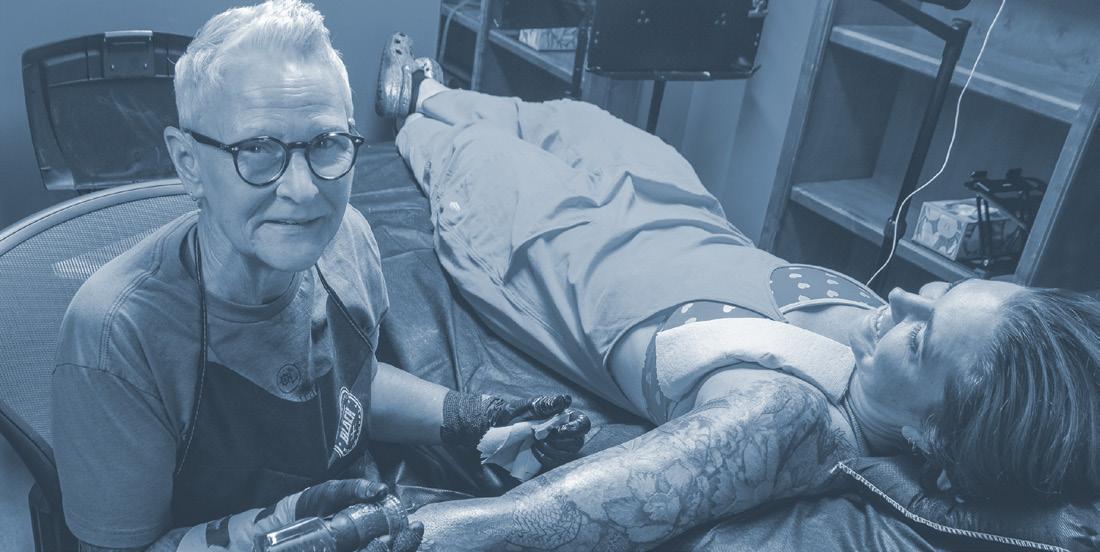
part of the Tattoo Heritage Project, which is dedicated to preserving tattoo history.
Diversity is tightly woven into every aspect of the shop. Barba makes an effort to hire tattoo artists of various backgrounds, ethnicities, and sexualities. The multitude of different tattoo styles that each artist provides also aids in the shop’s diversity principle.
The shop’s ability to properly understand the wants and needs of the customer is formed from their foundation of mindfulness and communication. Outer Limits encourages people to get their first tattoo at their shop because of their ability to provide proper accommodations to any customer and make everyone’s tattoo experience easy, fun, and memorable.
“We are super clean, super sterile, and super understanding," Barba said. "We will take the time to understand what kind of tattoo you want.” Whether
530 E. Broadway, papercranetattoo.com
Nestled away on Broadway is a tattoo shop that prides itself on creating a calming and welcoming atmosphere: Paper Crane Tattoo Studio. The owner, Mikey Vigilante, created a tattoo shop around the premise of a paper crane because of the peace that cranes symbolize.
“At the very core of this shop, I wanted to create a sanctuary for anyone to feel welcome,” Vigilante says.

Vigilante puts his words into action as he continues to actively build a tattoo safe haven that is open for anyone without judgment.
Suzanne Shifflett is an openly queer tattoo artist at Paper Crane. She uses her background in the fine arts to influence her work and uses art as a way to connect with any of her clients.
Paper Crane wants clients to feel secure that their tattoo artists will
Althoughonly two years old, Black Moon Lilith
Tattoo Studio has made its mark by being a queer, Black-owned small business that provides a homey environment for anyone who steps through its doors.
Entering the tattoo industry as a queer Black woman was no easy task, said owner Danielle McKnight, but it motivated her to open a shop and create a safe space for herself and for anyone else looking for a welcoming tattoo atmosphere.
Black Moon Lilith Studio was created to feel like a second home for anyone, McKnight said.
McKnight’s main goal for her studio is to be “an extension of her living room” and to not have an intimidating atmosphere. In order to make her customers feel safe and at ease in her shop, McKnight goes above the traditional dynamic of tattoo artist and customer by creating a relationship with every client.
McKnight knows how intimidating and scary entering a tattoo shop can be because of her own personal experiences working in the male-dominated tattoo industry. Because of those experiences, she
take care of them and wants to ensure that all customers leave their tattoo appointment happy with their results.
Cindy Ortega, a new hire at Paper Crane, says she got her first tattoo by Vigilante at the Paper Crane Studio. After finishing her tattoo apprenticeship, Ortega immediately reached out to Vigilante asking for a job. She says that Vigilante made her feel comfortable during her first tattoo, encouraging her to want to work with Vigilante and create that same positive experience for other clients.
In addition to Paper Crane’s aim of creating a calming and pleasant atmosphere for any customer, the studio has multiple artists of different backgrounds and specialities, ranging from cartoon to realism, and from American Traditional to traditional Japanese style tattoos.
David Gomez was a new customer to Paper Crane just a few months ago, but he has repeatedly dropped by since then for new flashes, common designs that are premade for customers to walk-in and choose. Gomez says that the reason why he likes coming to Paper Crane over any other tattoo shop is because of the variety of tattoo styles Paper Crane provides.
“There’s somebody that can do any style here,” he says.
968 E. Broadway
wants to ensure that her studio is a welcoming space that is friendly to everyone. There are free snacks for anyone to take, feminine hygiene products in the restroom, and popular rap or pop music playing in the background.
McKnight said she aims to ensure all her clients are comfortable throughout their session and happy with the result. At the end of each session, she also provides a bag with some snacks and after-care instructions for the finished tattoo.
“If you are looking for an experience and not just a tattoo, then my space is the perfect space,” she said.


STORY BY LUIS CASTILLA
Los Angeles-based band Healing Gems is creating spacey, atmospheric tunes with its unique blend of loungy psychedelic sounds.
The band is composed of singer and guitarist Jared Marin, keyboardist Edgar J. Mendoza, lap steel guitarist Patricia Mae Reyes, guitarist Brittany Carranza, drummer Michael Castellanos, and bassist Liliana Burgos. However, because of the band’s talents, they can freely swap instruments on stage and still sound great.
Healing Gems traces its origins to Castellanos’ basement circa 2015, where the group began by covering songs from Super Mario. Since then, the band has released three EPs and an album, “Fiesta Pack,” which is a collection of those EPs.
Marin admits that as they were starting out, members of the band were still learning to play their instruments. The band also grew in members over time and has had a few lineup changes over the years.
Burgos and Carranza are the newest additions. Marin says they bring a different perspective to the band, which he felt was necessary. He is also excited to see the influence Burgos and Carranza can have on future songs.
“We’re all from L.A. so it just always felt like their style and influences always felt very Long
Beach,” Marin said. “You can always tell when a band is from Long Beach.”
It’s hard to pin a single genre on Healing Gems. Marin says he too has trouble describing his band’s sound. He cites Italian films from the ‘70s and video games as some of the band’s biggest influences. “To be honest, when we write songs, we’re basically making a soundtrack every time,” Marin said. “I’m always imagining that we’re on a side quest and we have to unlock new powers.”
The band has nurtured a small but dedicated local following performing in and around Los Angeles, though they have also gone on tour around Japan and South Korea. Marin expressed that the majority of the band’s live audience is made up of friends of the band.
“I feel like when I look out to the crowd, I know everybody there, like everyone’s my friend,” Marin said. He added that he loves the atmosphere at shows, although he would like people to mosh more, which he admits is difficult when the music is so chill. The band is known to incite conga lines, however.
Healing Gems also hosts Tiki Trash, a yearly pool party and music festival at Castellanos’s home in West Covina. The band had their first show at the first Tiki Trash, where they would appear as

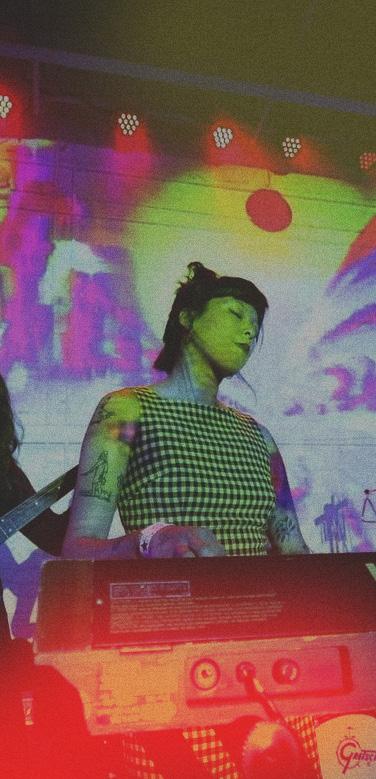
the secret headliners. “It’s an easy way to get a following,” Marin joked.
The festival was a lot more rowdy back in the day. So many bands would be on the lineup that not everyone got to perform. At the second Tiki Trash, someone broke the pool’s diving board and people had to be kicked out. The lineups are now capped at around seven bands and more rules have been implemented to keep guests from getting out of control.
Though the band has celebrated some success, it has experienced its share of ups and downs. Just before the COVID-19 pandemic, Healing Gems experienced a surge of momentum as they prepared for their album “Fiesta Pack” to be released, only to be sideswiped by a quarantine order.
Interestingly, Marin says the pandemic provided the band with a much-needed break. He explained that the band had been overworking itself and that the break let everyone focus on their personal lives. While the band would play a live-streamed concert during the pandemic, it had to cut its set short due to Castellanos developing appendicitis mid-set. He would go on to make a full recovery.
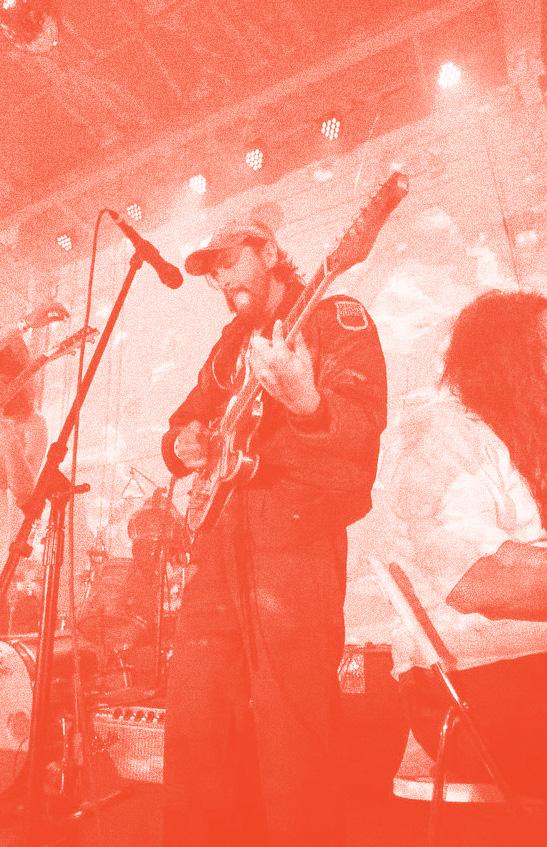

The local music scene was hit especially hard by the pandemic due to the lack of concerts. Many smaller bands did not survive this period. Healing Gems, however, was able to make it through to the other side and played an album release show at The Echo in Los Angeles on October 24.
The new album, “In The Mood,” includes songs the band has previously only played live. Marin describes the album as a refined version of their old sound.
Marin said it can be difficult to get everyone together due to conflicting schedules. Because he does not currently work, however, Marin had plenty of time to finish mixing the band’s new album.
Marin says he hopes to tour outside of California again, specifically on the East Coast and in Europe. He is eager to write more music that people can dance to.
“I just want people to feel like the way I feel when I hear some sound I’ve never heard before, like they’re on a foreign planet,” he said.

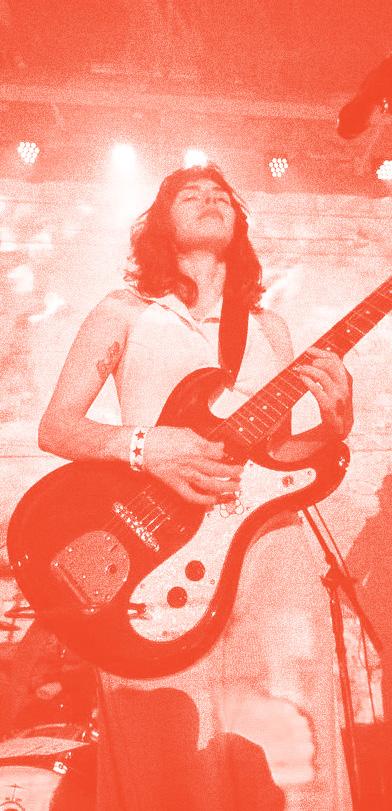






Iwas no longer hearing what my doctor was saying, as I watched his lips moving, explaining my test results to me. I was barely able to understand what was going on, only just aware of where I was and what I was feeling. I felt the cold of his office and the ache of my knees and realized I hadn’t had a sip of water since I left home. Where was my water bottle anyway?
My gaze wandered to the view behind him. There was a big window, with rather ugly yellowish curtains, which were drawn halfway. It wasn’t the bright yellow of a highlighter, or the fresh yellow of a lemon; instead, it was a dirty white, turned yellow from years of indoor smoking. How long had it been since someone had cleaned those curtains? My mind drifted back away.
“Are you all right? Do you want to take a break?”
The doctor’s voice pulled me right back to the cold of the office, and I felt the beginnings of an ache pulsing at my knees again.
“Yes. I mean no, we don’t have to take a break. I’m all right,” I said, though I felt that the break could have done me good. I was starting to feel really thirsty, and I could’ve sworn I brought my water bottle
with me, but I couldn’t remember where it was.
“You are experiencing what we call post-traumatic amnesia. After a traumatic brain injury, a period of confusion and memory loss can occur. Depending on the patient, these symptoms could last several days or sometimes several months. There really isn’t an exact way for us to determine how much memory loss can occur during this period or how long you will be affected.”
We were on the 12th floor of the Metroplex Wilshire, a business center located at the heart of Koreatown. The office view wasn’t anything spectacular. It was just like any other office building, overlooking other buildings that were not as tall. At least it’s better than a stark hospital setting, I thought to myself as I made my way toward the receptionist who was supposed to help me set up my next appointment.
She handed me a small card that had my next appointment date on it. It was in six weeks.


“We will also contact you before this date to confirm your appointment, so don’t worry if you lose the card or forget about it.”
Why would I forget about it? I have a traumatic brain injury, and this appointment is really important. Even if I forgot silly, small things like where I put my water bottle, this was an important appointment. The re was no way
Memories 1, Ulku 0.

“Amnesia felt like an endless game of hide-and seek...”
that I was going to forget about it. I am not going to forget about it.
“Thank you,” I said to the receptionist and walked out.
The weather was warm. My knees had stopped aching. My thirst was yet to be quenched. I just wanted to go home, have a sip of water and take a nap.
I forgot about the appointment. I forgot that I even made the appointment in the first place. I also forgot many other rather important things after that day. I also realized I forgot about many other rather important things that happened in my life before the accident. And I never did remember where I put my water bottle.
So he was right.
Amnesia felt like an endless game of hide-and-seek, where my memories were the elusive players, always hiding just out of reach. It was a frustrating chase; I often felt like I was the only one playing, while my memories reveled in their concealment.
About four months prior to my forgotten appointment, I was involved in a car crash. It was 6 a.m. and I had taken an Uber to work. I was still half asleep in the back seat. The sun was barely rising, and its light dimly illuminated the streets. Some people were walking their dogs, some were jogging, and a few elderly people were stretching in their lawns.
It was a nice, not-so-hot summer morning. It would’ve been nice to enjoy doing something I actually wanted to do rather than going to work, I thought, as I continued to gaze out the window. My thoughts were cut short when I saw a car coming toward me, too close and too fast.
Then there was chaos. In an
instant, the airbags exploded, filling the car with a loud whoosh. The sound of metal crumpling was deafening, and a horrific blend of crunching and shattering glass echoed in my ears. Is this what a cacophony sounds like?
The seat belt was loose on my chest as my body was thrown to the other side of the car. The air was thick with the smell of smoke, burnt rubber and the bitter smell of gasoline.
I freed myself from the seatbelt and opened the other passenger door since my door was completely crushed and merged with the other car. I tumbled down the car as if I'd forgotten how to walk for a brief second.
I crawled away from the car, not sure how long I stayed on the ground, or how the driver made it out of the car. The last vivid




image that remains engraved in my head was me sitting on the ground, staring at the car that I just came out of, while forcing myself to breathe.
What happened next only exists as fragments in my head. Choppy and incomplete. My habit of journaling really came in handy while I was trying to regain some of what I had forgotten. I remember going to urgent care, but I don’t remember what happened there.

“Not all is lost, but there is a big black hole that I can’t seem to fill...”
doing before the accident. The day, the week and even the month is gone. I’m not even sure how far back I can remember. Not all is lost, but there is a big black hole that I can’t seem to fill no matter how hard I try.
When I arrived at my follow-up appointment, I felt disoriented, as if I was floating in a dream where everything was slightly off-kilter. I was supposed to stay there for the next eight hours for extensive testing.

I remember arriving at multiple doctor appointments for scans and testing, but I don’t remember how I got there or what I was even told.
All I have is a few pages I managed to scribble at the end of the day.
I don’t remember what I was
“How are you feeling since the last time you came?” my doctor asked.
For a brief moment I wanted to lie to him, tell him that I was OK and that everything was fine. I was back to my normal life. I wasn’t forgetting appointments, faces, and conversations, missing deadlines, or struggling keeping up with school.
“Not great,” was all I could manage. At least I didn’t lie.
Eventually, I came clean with everything I was feeling
and experiencing. How I was struggling to retain anything new and couldn’t do anything to stop it. Moments would flash before my eyes, leaving me even more confused whether my brain was making this up, or if this was something that really happened to me.
It felt like holding onto coupons that were all expired, or looking through photographs that I couldn’t quite remember taking. I felt trapped between two worlds: the one I knew and the one I couldn’t access.
“I am going to tell you that it’s going to be OK. I have seen it all, trust me.”
I wanted to trust him.
“I know you are feeling confused and that is completely normal. But you need to focus on the present. Create memories that are worth remembering, even if they are something small, like reading your favorite book. The urge to force yourself to remember is very strong, I know, but you don’t
want to live in a past that you may not remember, ever.”
I wanted to trust myself, and I did, eventually. I stopped denying the inevitable truth and stopped chasing what I had lost. No matter how big the damage may have been, I was still here.
I am still here.
I read my favorite book again. I watched my favorite movies again. I bought myself a new journal, as well as a bunch of sticky notes, that eventually littered my room with duplicate copies of reminders and tasks I had to take care of, because it was how I would remind myself of what to do.
I asked Siri to remind me to eat. I created voice memos after a phone call or a meet-up with friends, because I did not want to forget the little details. I slowly
opened up to the people around me about what I was going through. I wasn’t always honest when I said “Oh yeah, I remember that day,” but it didn’t seem to hurt anyone.
Most importantly, I took my time.
Eventually, the fog of forgetfulness began to lift, but it wasn’t easy. Some days, a scent or a song would spark a fleeting memory, a glimmer of the person I used to be. I learned to celebrate these small victories, holding onto them like treasures. But other days felt heavy, the gaps in my recollection haunting me. It was a process of patience, like nurturing a fragile seedling — slow, painstaking, but with each new memory, I felt a little more whole. I was beginning to understand
that recovery wasn’t just about reclaiming what was lost; it was also about rediscovering myself in the spaces in between.
It has been a little over a year since the accident. My recovery is far from perfect, but significant progress has been made. I learned that there is no harm in enjoying the same things twice as if it were your first time. Also, forgetting a thing or two is sometimes a good thing, especially when you encounter unpleasant acquaintances.
The current score in this wild game of memory hide-andseek is:
Memories 1, Ulku 1.

Noharminenjoyingthe samethingstwiceasif itwereyourfirsttime!


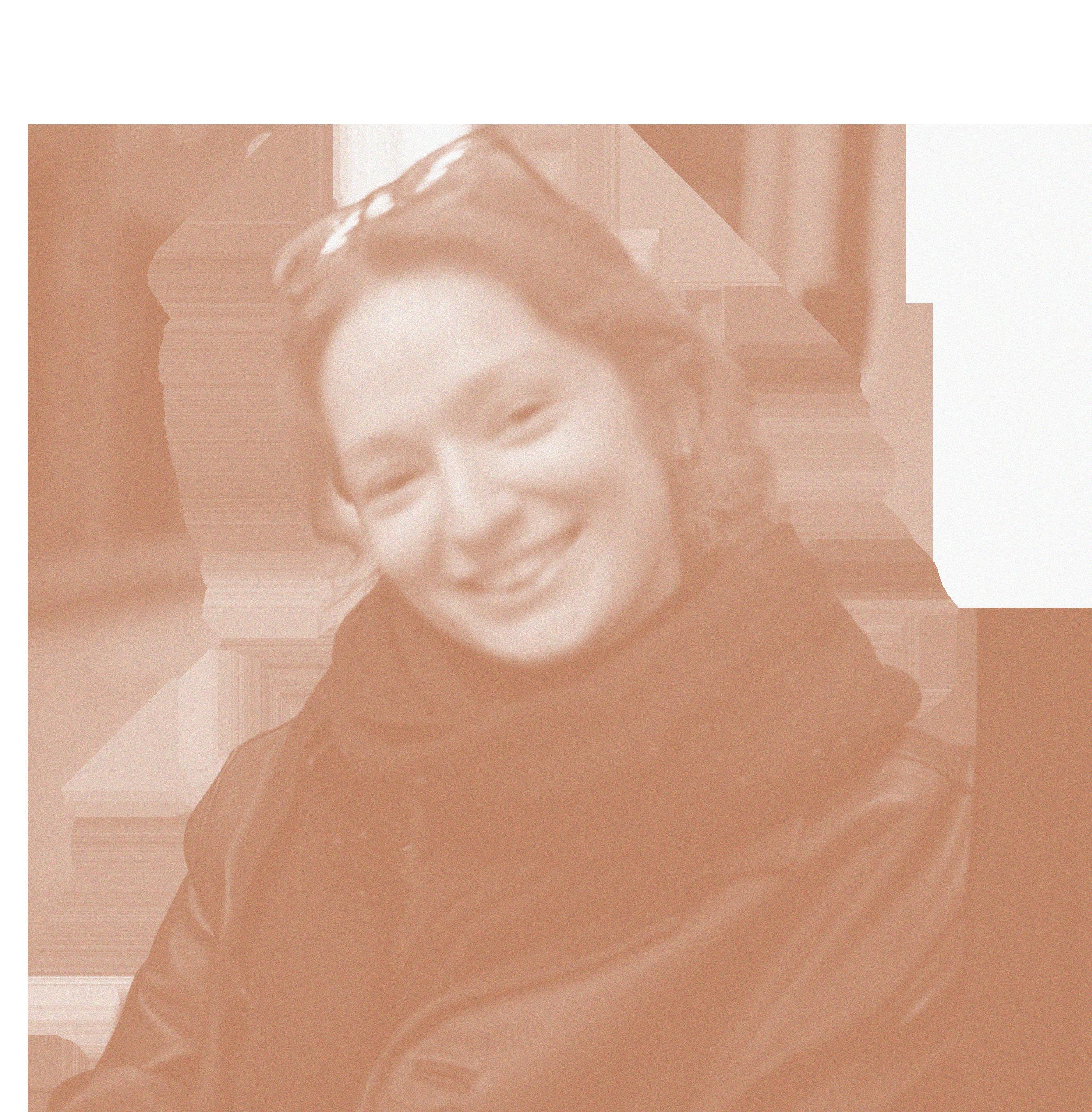

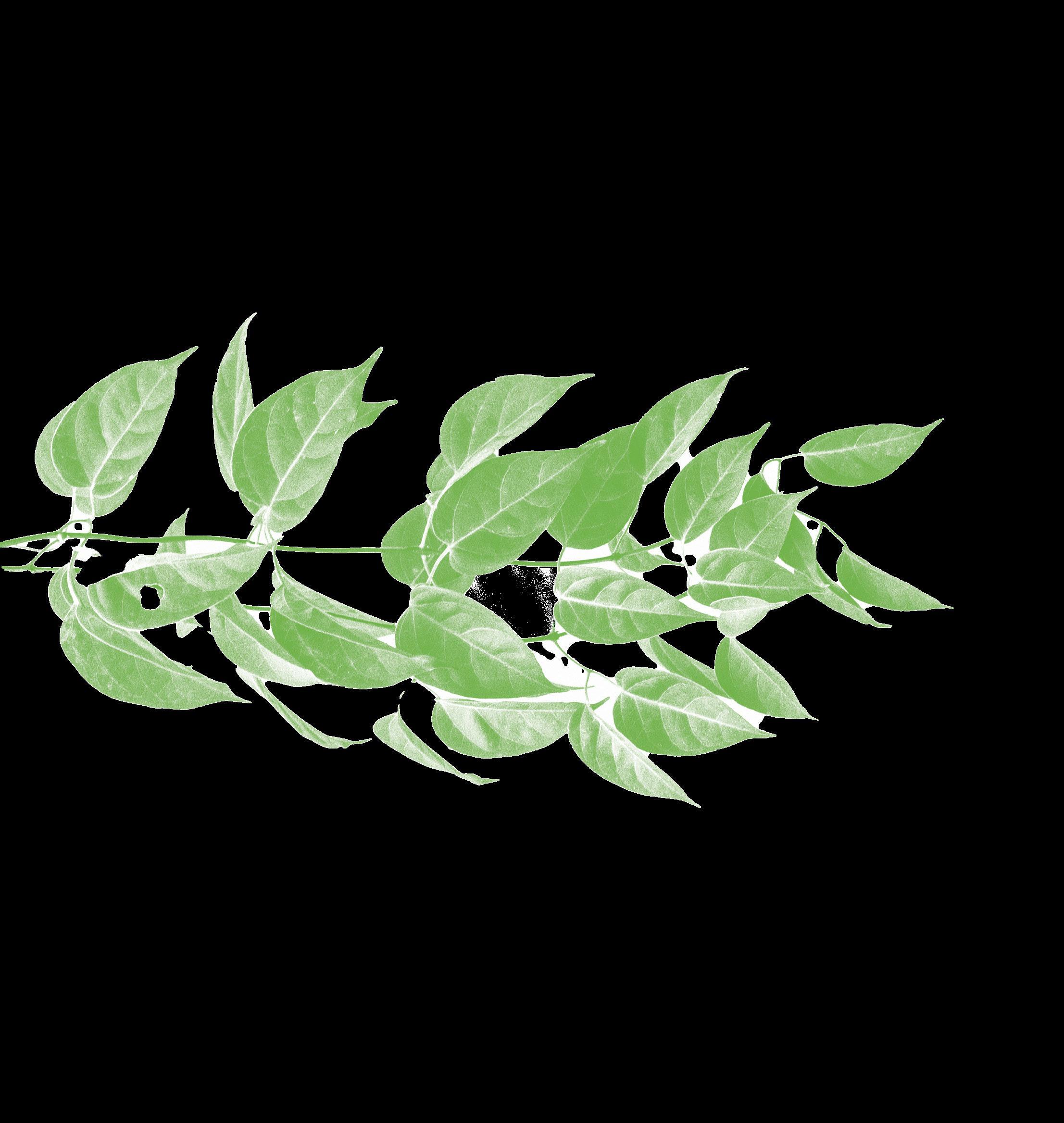

To help fight the use of pesticides within CSULB landscaping, students took inspiration from and joined the fight already beginning throughout many college campuses across the nation. Current Re:Wild CSULB president Alicia Newland accepted this challenge when she took on the goal of learning all about the benefits of a pesticide-free campus and the reintroduction of California’s native plants.
The introduction of pesticides to everyday groundskeeping made the caretaking and treatment of plants easier and less backbreaking due to chemicals taking the place of gardening and manual labor. Pesticides offered a quick and effective solution to killing invasive weeds and pests such as English Ivy and Lily of the Nile.
At the same time, the health effects and safety risks caused to humans and the environment were often ignored. “Synthetic pesticides are very carcinogenic and have many negative impacts to not only student
health but to all of the wildlife that lives here,” Newland explained. “Additionally, pesticides do kill off a lot of the small biodiversity and biological matter that’s within the soil. It just kills everything.
“[With the use of pesticides,] the ecosystem doesn’t really have a chance to have a self-sustaining cycle.”
“Re:Wild Your Campus” began in 2017 at the University of California, Berkeley, when two volleyball athletes became aware of the dangerous pesticides sprayed throughout their campus. They were alarmed that such products were being used in close proximity to students, inspiring them to promote a more organic campus environment — organic meaning eliminating all harmful chemicals while promoting soil health and a vibrant micro-ecosystem.
Now, Berkeley is 95% organic, and the effect of their work has trickled down to schools such as UCLA, Cal State Fullerton, and our very own Cal State Long Beach.


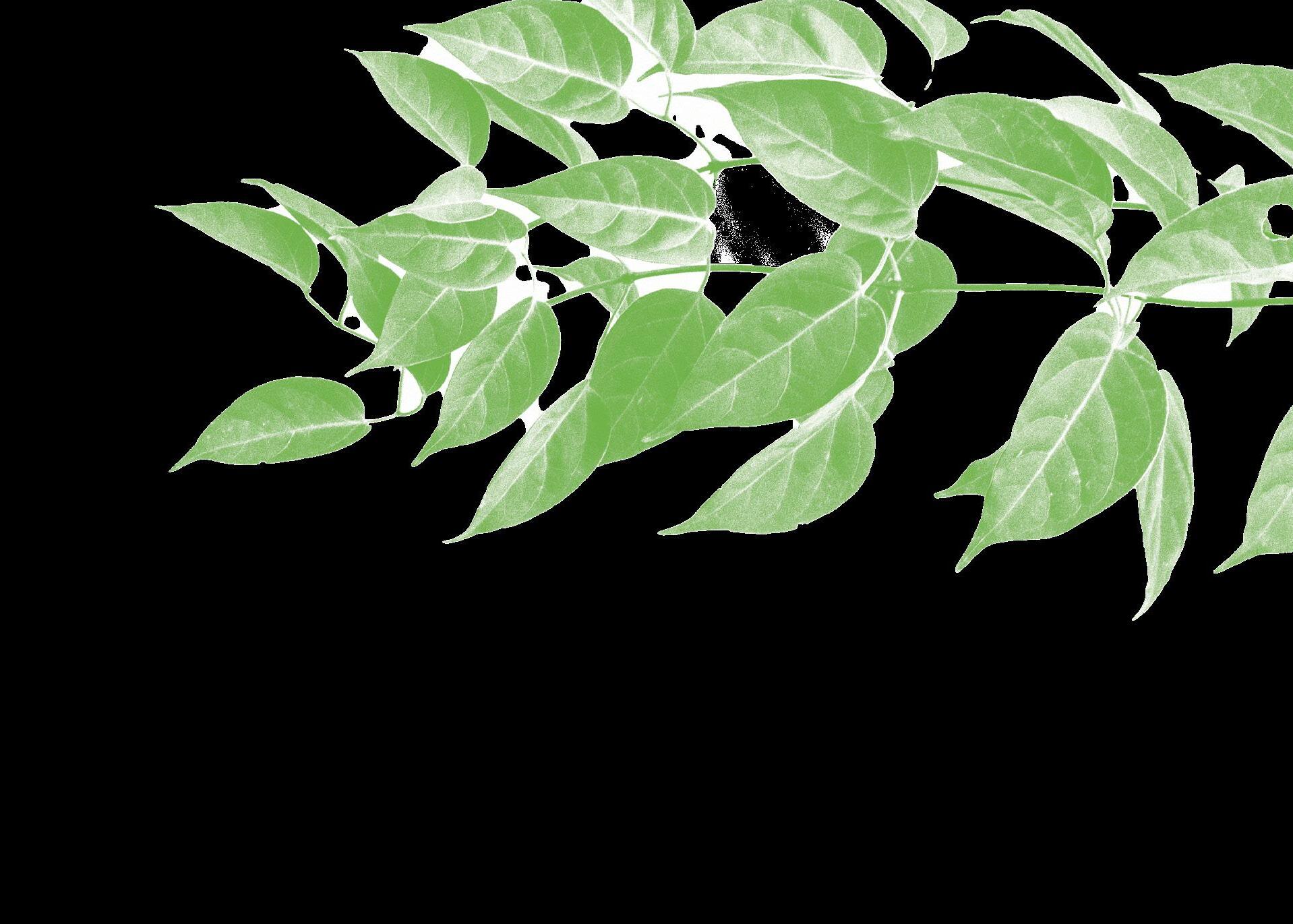

Cannon Hanson-Swartz began Re:Wild CSULB two years ago with the goal of removing all harmful pesticides from land management and promoting a more organic campus environment. During this time, he contacted school faculty and attended Board of Trustee meetings to persuade them that
this was the right future for the campus. A more eco-friendly campus environment would benefit both local biodiversity and student health by eliminating carcinogenic chemicals.
Newland, a senior majoring in environmental science and policy, did not initially know about the negative effects harmful pesticides could cause.
“[Before learning about Re:Wild,] I had no idea about any of the negative effects of pesticides,” Newland said. “I heard Hanson-Swartz speak after one of my classes, and over the course of the semester, I became super interested in what he was doing.”
Newland worked alongside Hanson-Swartz in their pursuit of a pesticide-free campus, learning about the best organic nurseries, how to source certain resources, and how to properly do everything to keep a site completely organic.
Along with doing her own research and finding more passion to pursue this goal, their final culmination was the beginning of the Organic Pilot Project, slated to begin in Fall 2024, with hopes of making CSULB
a pesticide-free campus by 2030. They aim to not only eliminate the use of harmful pesticides and reintroduce California native plant species, but also learn through different tests how their work impacts the natural environment.
Despite Hannon-Swartz’s efforts, the university pushed back Re:Wild’s plans, believing this path to be less cost-effective due to the prices of California native plants compared to non-native species and the effort required to care for them. Newland disagrees. “If people understood that over time, this solution [will be] a lot more cost-effective, better for the environment, and better for overall health to everyone, then I think a lot more schools would implement this more quickly.”
After Hanson-Swartz graduated in Spring 2024, it was left to Newland and co-president Tyler Hanks to continue pursuing Re:Wild’s goal. Without hesitation, they took up the mantle of leading Re:Wild CSULB into a more prosperous and organic-filled future. Working alongside CSULB’s ASI, they secured a 1,000-squarefoot plot of land located next to the University Student Union to finally begin their Organic Pilot


Project, which launched on Oct. 7.
“We are going to be manually removing the weeds and hand-watering the site,” Newland said. “And along with this, we plan to conduct data collections on both the soil and water usage.”
Re:Wild plans to use an eDNA soil test, designed to analyze the DNA left behind by organisms to determine the kind of species living in the area, while also cataloging the overall soil health over time. This will help them in determining what changes need to be made to increase the biodiversity of the project area.
“Right now, we have invasive plants that attract invasive pests, and there is nothing to eat those [invasive plants] because the pesticides kill everything off,” Newland said. Using these eDNA soil tests will give the Re:Wild club a tangible piece of evidence to show CSULB administration the costeffectiveness of planting California native plants and eliminating harmful chemicals and the better health effects both efforts provide to students.
Although the project has been pushed back multiple times, the fact that it has finally been approved is a step in the right direction, Newland said.
“That is a very important part in trying to get this

to be implemented and spread across campus,” Newland explained. “Once we graduate, we need someone to take care of the landscape, especially if this were to spread around campus. It would be hard for a small group of student volunteers to take care of every site.”
Their hopeful expansion of their Organic Pilot Project is why Re:Wild largely depends on the kindness of volunteer students who also wish to see change within the campus’ environment.
With the teachings of former president and founder Hanson-Swartz passed down to Newland, it is up to her and her club officers to continue pushing for a healthier campus environment and march forward without the use of pesticides.
“If people understood that over time, this solution [will be] a lot more cost-effective, better for the environment, and better for overall health to everyone," Newland said, "then I think a lot more schools would implement this more quickly.”

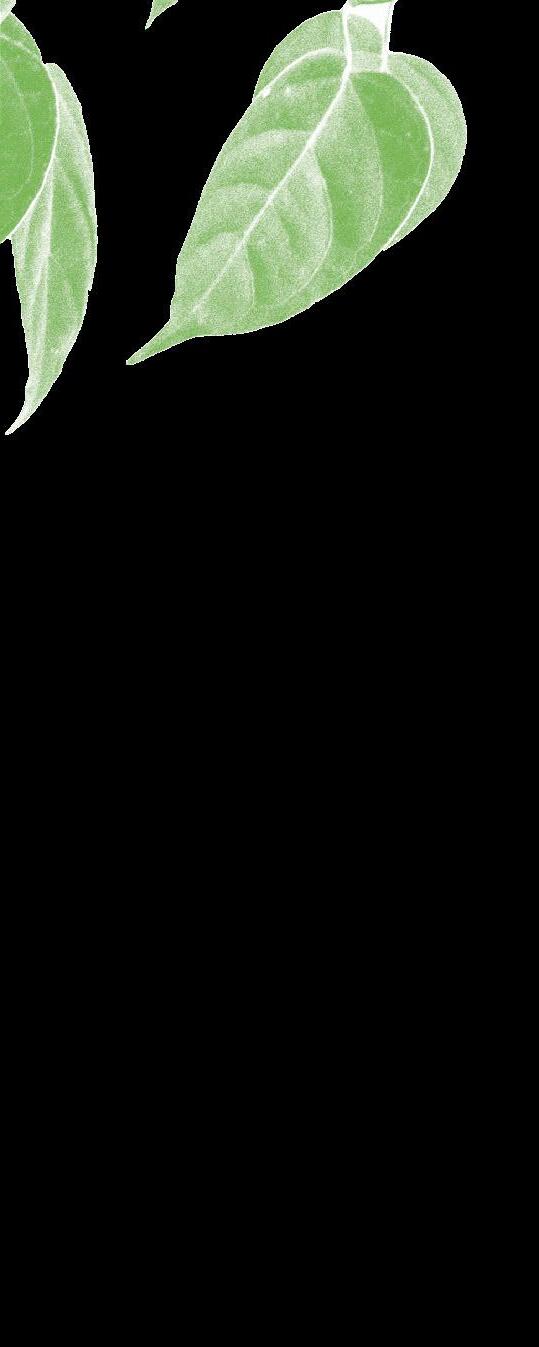

The Long Beach Walking Club is a club rooted in community, sisterhood, and fitness. With growing numbers everyday, the club is a breath of fresh air for young women who want to make friends and engage in the beautiful community of Long Beach.
The distant buzz of women’s laughter and voices can be heard in Long Beach during early mornings or afternoons.
If one were to glance up, they’d spot a flock of women walking along the sidewalk. There is a welcoming energy with a tinge of shyness that follows them. They are a diverse group of various sizes, colors and ages, dressed in different variations of workout attire. Some hold giant water bottles. Others wear backpacks. A small number even bring their dogs to be intermingled in the group. And leading the very front of the line is 31-year-old Evelyn Avila, who guides the happy group, holding a small white flag that spells out, “The Long Beach Walking Club.” Avila is the proud creator and founder of the Long Beach Walking Club.

“At the time, there were walking clubs all over Los Angeles, and I thought, ‘Why not in Long Beach?’” Avila recalled. “I wanted to build a community for women. Walking is such an unassuming way for people to connect.”
So she got to work. Using her background in social media marketing, she created an Instagram page and began posting to promote the club and eagerly prepared for the first walk, in April of 2023.
Only two people showed up.
Even with the feeling of discouragement, Avila persisted. She worked harder, doing her best to get the club’s name out there.
“There were a lot of challenges," Avila said. "I was doing everything myself. I was so burned out… That was when my amazing ambassadors stepped up and helped. They saw potential and believed in the club. They wanted to fight for it.”

“I
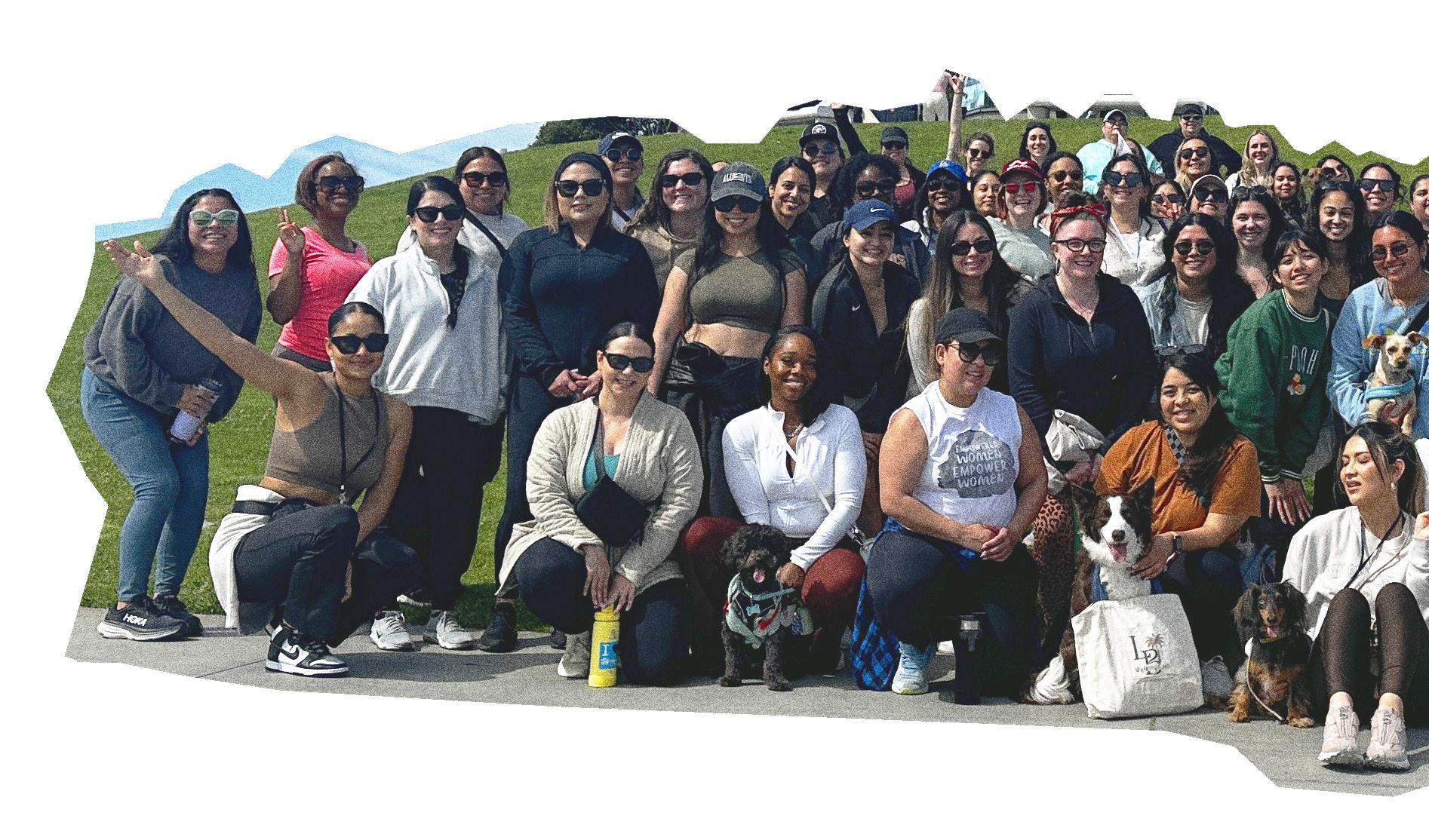
events that aim to give back to the Long Beach community. For example, they have events paired with walks called Social Hours, where women are able to connect with others while supporting Long Beach local businesses. These ambassadors are broken up into three groups: social media, philanthropy and community. They are affectionately called the “heartbeat of the Long Beach Walking Club” on the club’s website.
“From the very beginning [of] when I joined, I knew it could become something. I was fully in,” said Mileisely Long, 31-year-old vice president and ambassador. She joined in January of 2024.
All club officers and ambassadors are volunteers. Any money made from merch and event ticket

stuck in this bubble," Avila said. "This club unites women… I may be the face of the club but they do a lot in the background. They connect us to everything.”
It was in February of 2024 that things took a dramatic turn after the club posted a video to social media following a trending audio.
Quickly, the number of people who participated in meet-ups skyrocketed. What started off as a handful of participants leaped to numbers that have reached as high as 270.
The appeal of the club is rooted in finding community and connection through fitness. Avila recalls a time when a therapist came to their mindful social hour. Women were able to talk about mental health and encourage empowerment. They also
FEATURE · LONG DISTANCE FRIENDSHIPS participate in beach clean-ups and food drives and work with organizations like women's shelters.
The demographic of women who attend the walks range in age from 24 to 40. However, women of all ages are welcomed to participate.
“We had a conversation at a walk where women shared why they started walking, and a lot of them shared that, as adult women with responsibilities, like work and family, it is hard to make friends," said 29-year-old Marelyn Hernandez, who is an ambassador for the club in philanthropy. "Me being in the same boat, I thought, ‘I’m not the only one!’ It was a really nice moment.”
The club hopes to garner more interest, as meeting new people is one of the things that members enjoy the most.
“Just show up, don’t be afraid to show up alone,"
Long said. "We encourage everybody to meet somebody new when they attend walks.”
Avila is in the process of applying for non-profit status for the club. The status would allow them to invest funds into expanding the club.
“In the future, I want a walking club in every neighborhood of Long Beach,” Avila said. The club plans to expand their locations on where they walk. Walk meetup locations have a list of requirements, such as having enough parking for walkers, sidewalks with enough space for three people, and a location in a public area. Cal State Long Beach is one of the many locations they hope to walk at.
“I want women to know, it’s OK to put yourself out there," Avila said. "Anyone is welcome to participate."
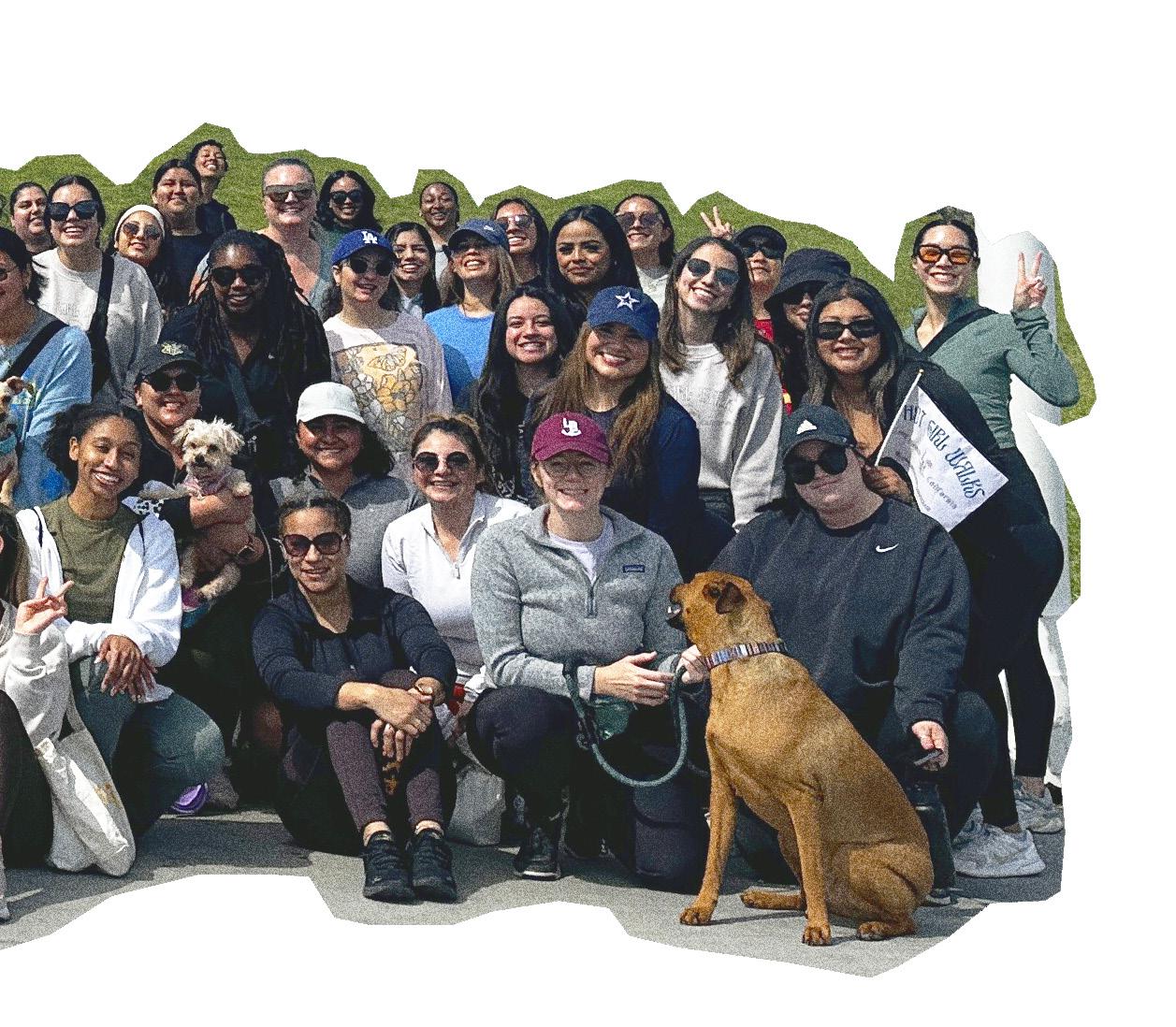

"Since posting a viral video on Instagram, the amount or participants has skyrocketed. On average, 90 people come to walk meet ups."



The truth is, microplastics are killing us. When I run my hand down a cold cucumber, dripping with sweat, I think of contamination. Each sweet nectarine, every plush peach, the red cherries picked from the tree, all contain tens of thousands of tiny plastic beads. Beads, fibers, film, and filament. I press the ripe fruit to my mouth, fill it with the flesh. You too are alive with plastic.
Researchers have discovered microplastics in every part of our body. In the brain, our lungs, our hearts, and tongues. When I kiss you, I taste plastic. One day, when they burn our bodies, an acrid smell will fill the air, and our ashes will mix immortality. Immortal plastic, that’s mankind’s gift to the earth.
I sit in a small white room. Where I work, we examine the plastics found in bodies. Each person is brought in carefully, wrapped in sheets. Grandfathers, grandmothers, uncles, parents, siblings, and babies. We slice into their skin with thin knives, taking samples. In the eye of a man, I find a long red string. Perhaps it came from a polyester Christmas sweater. In the guts of a 7-year-old girl, a microscopic plastic star. The bodies of the victims of my work are littered with plastic, and each piece is unique, like snowflakes on a winter day.
The room next door is where you work. A clumsy man who never wears socks the same color. You are testing, rigorously, a way to destroy the plastic. You work with fungus, with algae, with bacteria. Something must learn to eat the plastic, you argue.
“It took 30 million years before fungus could break down wood. So it’s possible that something could learn to eat plastic,” you say to me one night, pressing cooked steak to your lips. The steak is pink inside, dripping out a dark brown fluid.
“We don’t have that long,” I point out, drinking some of my wine.
“No, we don’t,” you reply with a chuckle.



Tonight, you come home from work dejected. Your hair is messy, your nose marked with the red indent of goggles. You sit on our patio, staring out at the stars, tiny spots of glitter in the sky. Plastic glitter became illegal last year, but when we look up at night, we can still see the memory.
“It’s no good. We’ll never fully break it down. The plastic will kill us before we make something that can destroy it. That’s what everyone in the lab is thinking. We don’t say it, but we think it,” you say, rubbing your eyes.
“How long is human history?” I ask, resting my head on your shoulder.
“About two hundred thousand years, I think. Why?” you ask, returning your glasses to your face.
“Plastic was invented in 1907. Before that, we had hundreds of thousands of years without it.”
“So?”
“So I think we’ll either become it, or it’ll become us. Do you get what I’m saying?”
“No, I have no idea what you mean,” you laugh, shaking your head.
But I know what I mean. In my heart, there is a sharp piece of acrylic. When I am cut into, when it is removed by scientists younger than me, from my own organs I’ve never seen, it will be a part of me. Like my bones, my teeth, and my hair. We will become plastic, eternal. And when the fungus learns to eat us, when the microorganisms tear apart the molecules of polyethylene, we will still be human.
My soul is older than plastic. I think yours is too.




So you’re here, laying in the waves. Letting the wet sand stick to the back of your head and the water soak your jeans.
You drive here after a particularly nasty fight with yourself, knowing that no matter the outcome all you can do is take some ibuprofen and get the hell out of the house. What is it about this time?
So you’re here, sitting in the parking lot shouldering your jacket arm by arm as you get out of your car and begin to walk to the sand leaving your shoes as they would just be another worry.
The grave and inflexible hardness of the asphalt becomes chilled smooth concrete becomes the television static of sand giving way to your heels You’re not there yet, stay focused.
You stop where the high tide would be an hour ago and do everything you’re supposed to do. Close your eyes, breath in deeply, brush your hands through your hair.
Listen to the orchestra of wind and waves and distant cargo ships, all as some sort of pseudo-meditative ritual.
Under the dull purple sky you’re now here. You sit down resting your legs and pull from your pocket your phone and tangled earbuds.

The sounds of the coast, now muffled by a drone of synthetic woodwinds and harps surrounded by irreverent glitches keys and discordant cellos droning on and on in repetition towards what you could only call the divine.
Now is the time to start taking it in. Laying on your back and shutting your eyes once again you search for any winning argument for however long. You tried god. You tried drugs. You tried sex. What have you got left?
You say art nowadays, so you throw yourself into all of it. Consumption and creation have become so integral to who you are.
Labor of necessity is the way you put it. Necessity for some kind of escapism from the constant fighting. So you don’t spend the rest of your time here, anywhere but here or there
Dressing your wounds and laying in the waves. or there
Dressing your wounds and laying in the waves.

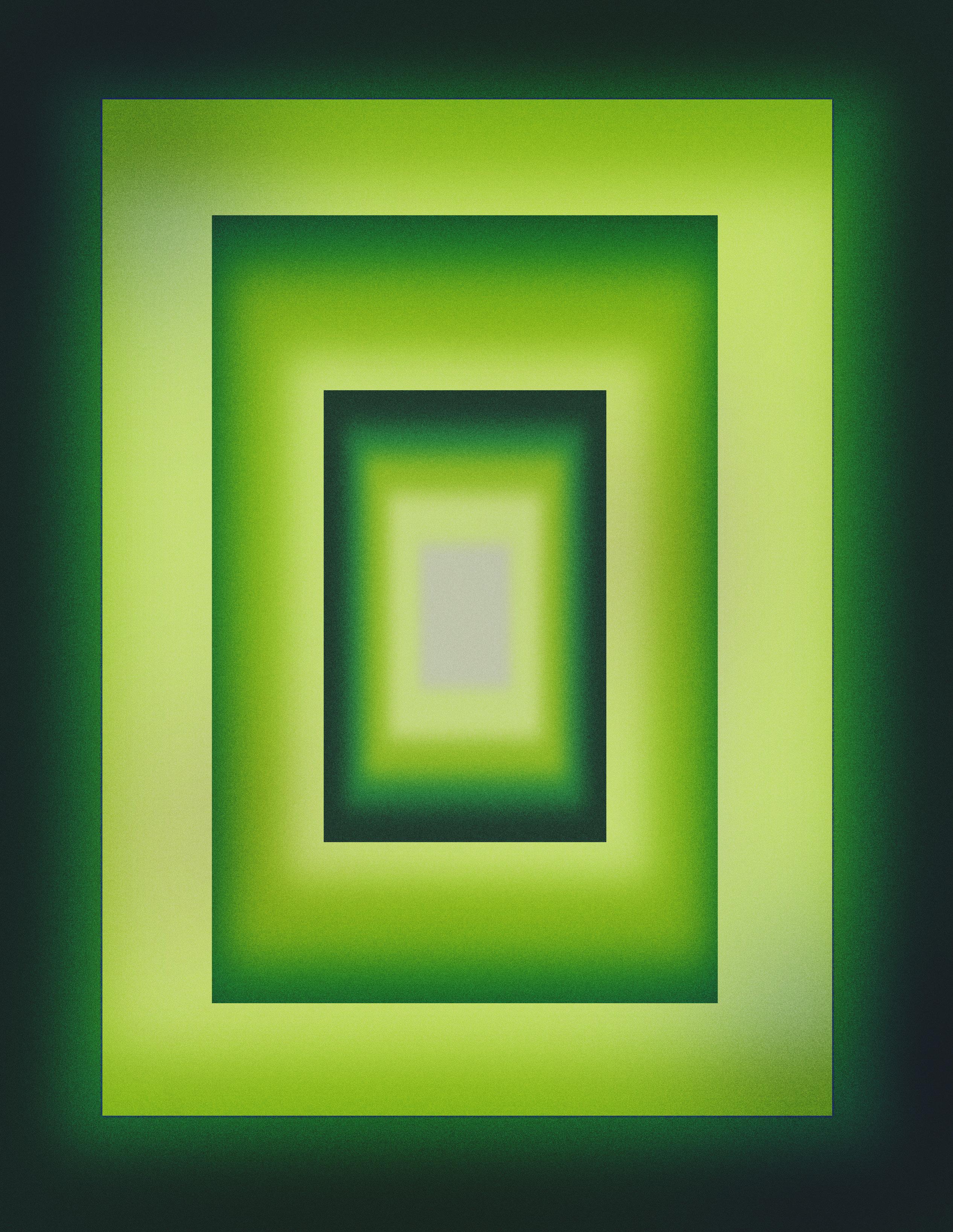

Show Your Beach Pride with a Go Beach Debit Card!
Plus, receive $50 to Beach Shops (with Promo Code BEACH2024) upon opening your new Membership with checking account!*

*Visit lbsfcu.org/beach for complete offer details or come see us at our campus branch located on the 2nd floor of Beach Shops

